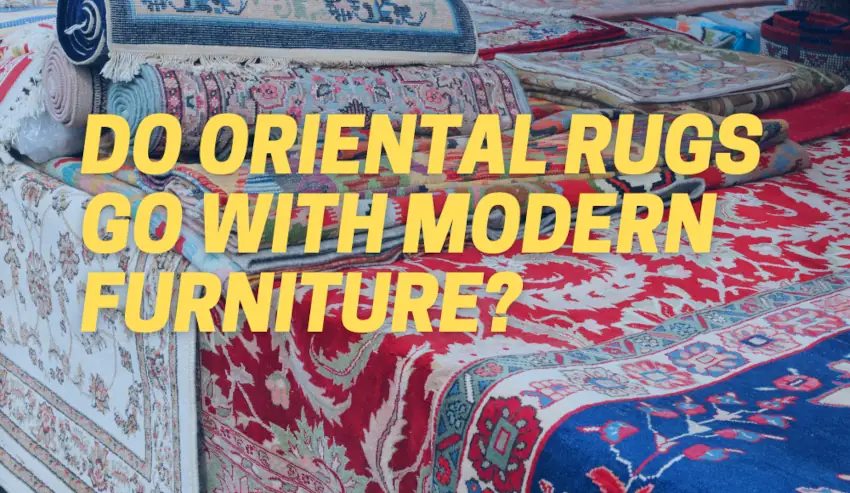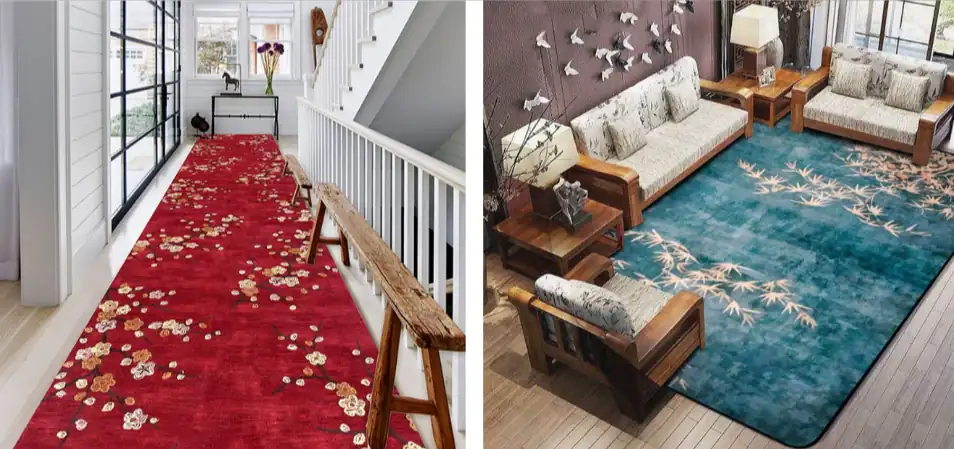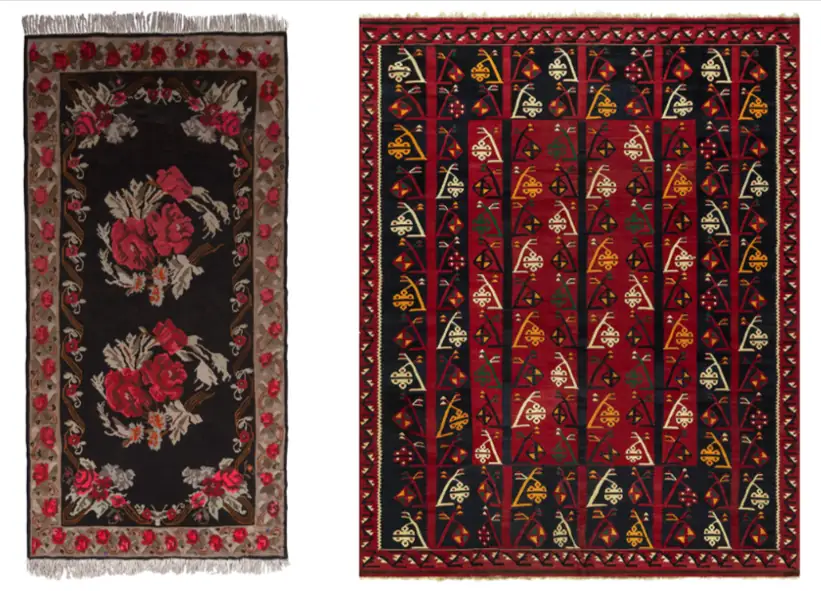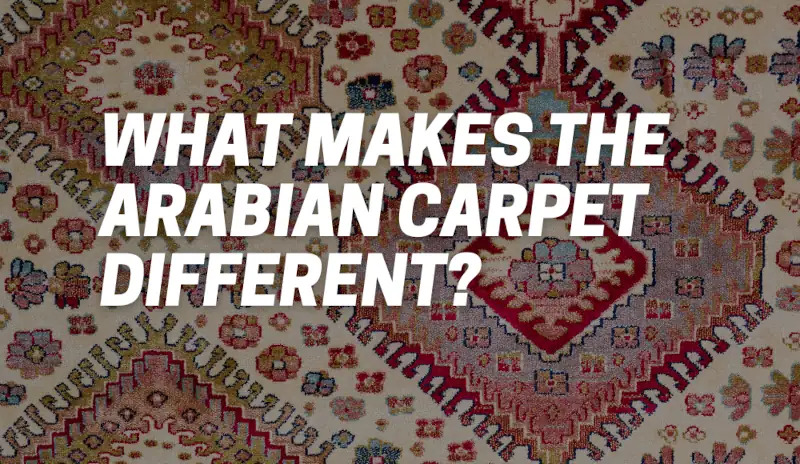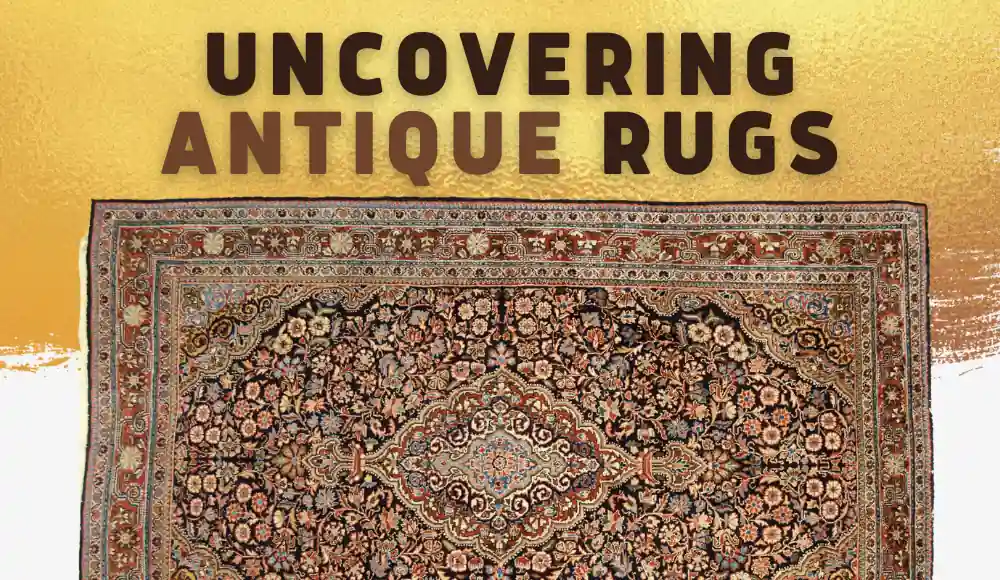If you’re in the process of decorating your home and have fallen in love with Oriental rugs, you might be wondering whether oriental rugs go with modern furniture and if they can seamlessly blend with your modern interior.
The good news is that when it comes to interior design, rules are meant to be broken. With a thoughtful approach and a keen eye for aesthetics, you can create a stunning fusion of traditional and contemporary styles.
In this blog post, we’ll explore the compatibility of Oriental rugs with modern furniture, provide some valuable tips for decorating with Oriental rugs, and answer frequently asked questions to help you achieve a harmonious and stylish look.
Can You Mix Modern with Traditional?
Before delving into the specifics of Oriental rugs and modern furniture, let’s address the broader question of mixing modern and traditional styles.
The answer is a resounding yes!
In fact, combining different design styles can add depth, character, and visual interest to your space.
Mixing modern and traditional elements allows you to create a unique and personalized environment that reflects your individual taste.
Can Oriental Rugs be Modern?
While Oriental rugs are often associated with classic and traditional interiors, they can also be incorporated into modern settings.
These versatile rugs have been evolving over time to cater to changing trends and design preferences.
Today, you can find Oriental rugs that feature modern patterns, vibrant colors, and contemporary motifs, making them suitable for various interior styles, including modern and eclectic spaces.
By choosing an Oriental rug with a modern twist, you can seamlessly blend it with your modern furniture.
Do People Still Decorate with Oriental Rugs?
Absolutely! Oriental rugs have stood the test of time and continue to be a popular choice for homeowners and interior designers alike.
These rugs exude a sense of history, artistry, and craftsmanship that adds a touch of sophistication to any room.
Whether you’re decorating a traditional, transitional, or modern space, Oriental rugs can serve as captivating focal points, tying the design elements together.
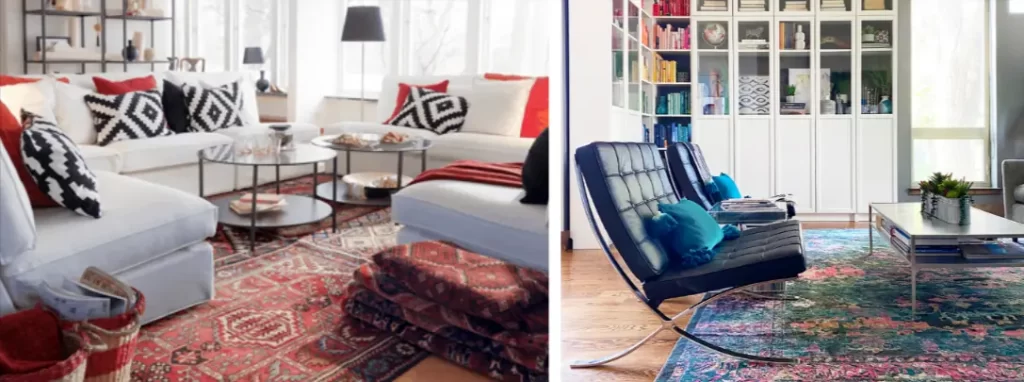
Are Oriental rugs making a comeback?
For instance, are Persian rugs out of style, or are Oriental rugs timeless?
Oriental rugs (or Persian rugs) are indeed making a comeback in the world of interior design. After a period of favoring minimalist and contemporary styles, there has been a resurgence of interest in incorporating more traditional and vintage elements into modern spaces.
Oriental rugs, with their rich history, intricate designs, and timeless appeal, have become sought-after additions to both residential and commercial interiors.
One of the reasons behind this revival is a growing appreciation for craftsmanship, authenticity, and unique statement pieces.
Oriental rugs are handmade using traditional techniques that have been passed down through generations, resulting in exceptional quality and attention to detail. They bring a sense of artistry and character to a room, elevating its aesthetic appeal and creating a focal point that sparks conversation.
Moreover, Oriental rugs have the versatility to seamlessly blend with various design styles, including modern, eclectic, and traditional.
Their bold colors, intricate patterns, and rich textures add warmth, depth, and a touch of exoticism to contemporary spaces.
They create a captivating contrast when paired with sleek, minimalist furniture, infusing the room with a sense of heritage and individuality.
Furthermore, the increasing interest in sustainability and conscious consumerism has contributed to the renewed popularity of Oriental rugs.
These rugs are often made from natural materials like wool or silk, which are biodegradable and renewable resources. They are long-lasting and can be passed down as heirlooms, reducing the need for disposable decor and promoting a more sustainable approach to interior design.
As a result, designers and homeowners are embracing the charm and beauty of Oriental rugs once again, integrating them into their interiors as statement pieces that reflect their appreciation for history, culture, and timeless elegance.
Whether it’s a vintage find or a contemporary interpretation, Oriental rugs are undoubtedly experiencing a resurgence and finding their place in the modern design landscape.
What Do You Call Oriental Rugs Now?
The term “Oriental rugs” is still commonly used to refer to rugs originating from various countries in Asia, such as Iran, Turkey, China, and India.
However, it’s worth noting that in recent years, there has been a growing movement towards using more specific and culturally accurate terms to describe rugs based on their country of origin or specific style.
This shift aims to avoid generalizations and to recognize the diverse heritage and craftsmanship behind each type of rug.
Therefore, you may also come across terms like Persian rugs, Turkish rugs, or Kilim rugs, which provide more specific information about the origin or style of the rug.
Can You Put Furniture on an Oriental Rug?
Certainly! Oriental rugs are not only meant to be admired from a distance; they can also serve as a foundation for your furniture.
Placing furniture on an Oriental rug helps anchor the pieces and creates a cohesive look in the room.
Additionally, it provides a practical benefit by protecting your floors from scratches and wear.
Just be sure to choose a rug size that allows all the furniture legs to rest comfortably on the rug for a balanced and visually pleasing arrangement.
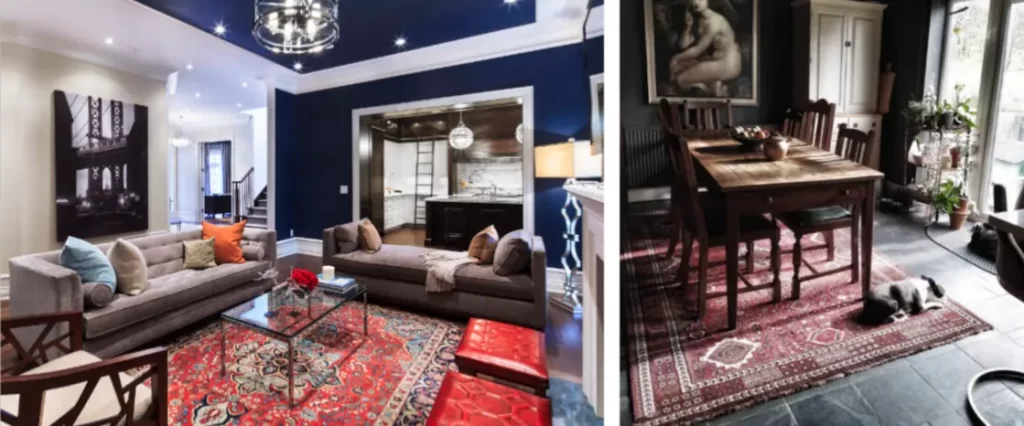
Oriental Rugs and Modern Furniture 101
Types of Oriental Rugs
There are several types of oriental rugs available in the market today, each with its own unique characteristics and designs.
Some popular types include Persian rugs (from Iran), Turkish rugs (from Turkey), Afghan rugs (from Afghanistan), and Indian rugs (from India). They vary in size, color palette, pattern design, and knot density.
For example, Persian rugs usually have intricate floral designs with a wool pile on cotton foundation while Afghan rugs are known for their red color and geometric patterns which reflect tribal influences.
Overall, oriental rugs offer an exquisite addition to any space due to their rich history and cultural significance combined with remarkable craftsmanship that has been passed down through generations making each one special in its own right.
Modern Furniture
Modern furniture is often associated with clean lines and minimalist design. Unlike traditional or antique furniture, modern furniture puts a greater emphasis on functionality and simplicity.
The term “modern” generally refers to furniture that was designed in the mid-20th century onwards, although it can also include more recent designs.
Definition of modern furniture
Modern furniture is often characterized by its sleek, streamlined appearance and minimalist aesthetic. Rather than being ornate or decorative, modern furniture typically features simple geometric shapes and clean lines.
This style is very popular in contemporary interior design and is often used to create a sense of openness and space in small living areas.
Characteristics of modern furniture
One of the key characteristics of modern furniture is its simplicity. Modern pieces tend to feature straight lines, sharp angles, and flat surfaces rather than curves or intricate details.
Many modern pieces are also designed with function in mind, such as storage solutions built into sofas or chairs. Another defining characteristic of modern furniture is its use of materials.
Many pieces are made from materials that weren’t commonly used in traditional styles, such as plastic, metal, or glass. These materials help add to the futuristic look that’s so often associated with the style.
Popular materials used in modern furniture
In addition to plastic, metal, and glass, many modern designers also use natural materials like wood or leather in their pieces.
However, unlike traditional styles which might showcase these materials through ornate carvings or detailed embellishments, modern designs tend to showcase the material itself more prominently.
Some popular types of wood used in modern furniture include teak and oak.
These woods have a natural grain pattern that adds visual interest without detracting from the overall geometric design of a piece.
As for leather upholstery options that are popular among designers include top-grain leather which is known for its durability, and bonded leather which is a more affordable synthetic option.
How Do You Match Furniture to Oriental Rugs?
Matching furniture to Oriental rugs requires careful consideration to achieve a harmonious balance.
How to Mix Oriental Rugs with Modern Furniture
Color Coordination Tips
When mixing oriental rugs and modern furniture, it is crucial to ensure that the colors complement each other. You do not want the colors of your rug and furniture clashing and overwhelming your space. The key is to choose a color scheme that complements both elements.
For example, if you have a colorful oriental rug with reds, blues, yellows, and greens, look for neutral-colored modern furniture that will not compete with the rug’s pattern or color scheme. Alternatively, if you have a solid-colored rug, you can add pops of color in your modern furniture pieces.
Another option for color coordination is to choose one or two accent colors from your oriental rug and incorporate them into your modern furniture pieces.
For instance, if you have a red oriental rug, you can look for red throw pillows or curtains for your white sofa.
Pattern Matching Suggestions
Matching patterns between your oriental rug and modern furniture gives a cohesive feel to the space while maintaining visual interest.
When pairing patterns between the two elements ensure that they are complementary yet distinct patterns so they don’t compete against each other.
If you have a heavily patterned oriental rug consider choosing solid-colored modern furniture pieces as too much pattern can overwhelm space. On the other hand, if you have solid-color rugs choose bold-patterned fabrics like geometric designs in chairs or curtains.
Placement Ideas
Placement is essential when it comes to mixing styles in interior design – it can make or break a room’s aesthetic appeal.
One way of placing an Oriental Rug in a room is by placing one under the coffee table in front of sofas or armchairs; this draws attention while also defining an area within an open-plan living space.
Alternatively, place Modern Furniture over compelling Oriental Rugs to add texture and depth to the space. You can select a statement piece like a couch, loveseat, or armchair to place over the rug.
For instance, you can place a white leather sectional sofa atop your oriental rug for an elegant and modern touch. Mixing oriental rugs with modern furniture can create an eye-catching and dynamic space.
The key is to ensure that colors complement each other, patterns match in style without overwhelming the room, and placement enhances the overall look of space. With these tips and ideas in mind, you can mix and match your Oriental Rug with your Modern Furniture confidently!
Examples of Successful Pairings
Real-life examples from interior design experts
When it comes to mixing different styles, there are no hard and fast rules. However, there are some general guidelines that can help you create a harmonious space. To get a better idea of how oriental rugs can go with modern furniture, let’s take a look at some real-life examples from interior design experts.
One example is the work of designer Martyn Lawrence Bullard, who mixed an antique rug with a modern home interior.
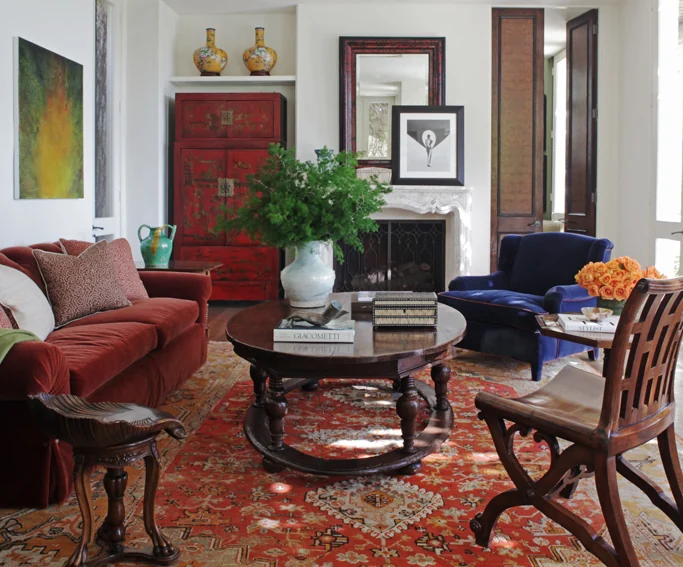
Do Oriental Rugs Go with Modern Furniture?
Yes, Oriental rugs can absolutely go with modern furniture! The key is to find the right balance and create a visually pleasing contrast between the two styles.
By mixing the richness and history of an Oriental rug with the clean lines and simplicity of modern furniture, you can achieve a captivating blend that showcases the best of both worlds.
The juxtaposition of the traditional and contemporary elements adds depth and visual interest to your space.
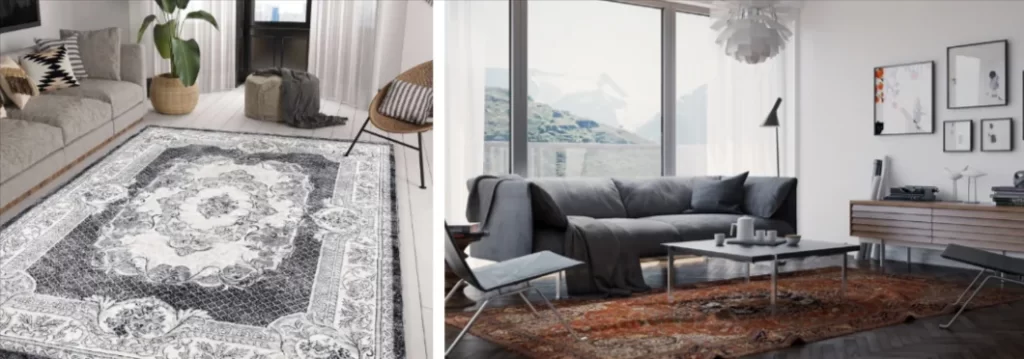
Best Oriental Rugs to Mix with Modern Furniture
When selecting Oriental rugs to complement modern furniture, it’s helpful to consider certain characteristics that enhance their compatibility.
Here are a few types of Oriental rugs that often pair well with modern furniture:
- Kilim Rugs: Kilim rugs are flat-woven rugs with geometric patterns and bold colors. Their minimalistic and contemporary aesthetic makes them a popular choice for modern interiors.
- Overdyed Rugs: Overdyed rugs are antique Oriental rugs that have been dyed with vibrant, modern colors. Their fusion of traditional craftsmanship with a contemporary color palette creates a striking and trendy look.
- Subtle Traditional Rugs: Look for Oriental rugs with more subtle and understated patterns. These rugs provide a timeless elegance that can seamlessly blend with modern furniture without overpowering the space.
- Neutral Rugs: Neutral-colored Oriental rugs, such as those in shades of beige, gray, or ivory, offer a versatile backdrop that can easily harmonize with modern furniture. They provide a sense of balance and allow other design elements to shine.
Turkish Kilim rugs
Tips for Decorating with Oriental Rugs
To help you create a cohesive and visually pleasing interior design with Oriental rugs, here are some valuable tips to keep in mind:
- Layering: Experiment with layering rugs to add depth and texture. Place a smaller Oriental rug on top of a larger, neutral-colored rug to create an interesting visual effect.
- Balance the Room: Ensure that the size of your Oriental rug is proportionate to the room and furniture. Avoid rugs that are too small, as they can make the space feel disconnected and disjointed.
- Accessorize Thoughtfully: Complement your Oriental rug with carefully chosen accessories, such as throw pillows, curtains, or artwork, that echo its colors or patterns. This helps create a cohesive look throughout the room.
- Consider Traffic Flow: Take into account the traffic flow within the room when placing your Oriental rug. Avoid obstructing doorways or creating tripping hazards.
- Regular Maintenance: Keep your Oriental rug looking its best by regularly vacuuming and professionally cleaning it. This helps preserve its colors and patterns and ensures its longevity.
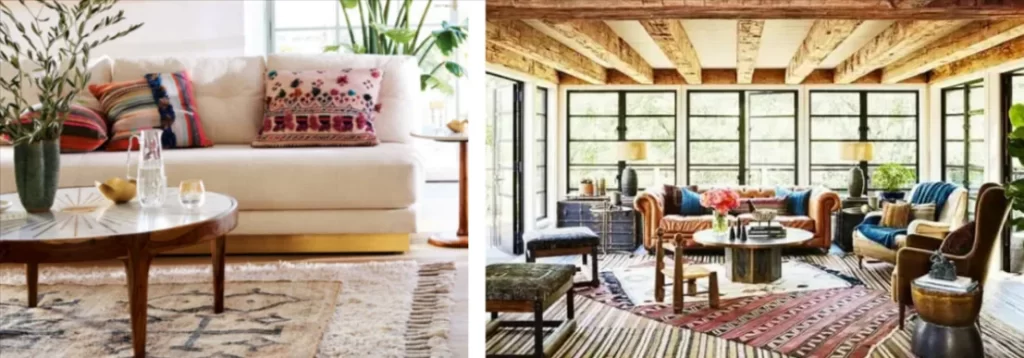
How Do You Mix and Match Oriental Rugs?
Mixing and matching Oriental rugs can be a creative and fun way to add personality to your space. Here are a few ideas to inspire you:
- Size Variation: Combine rugs of different sizes to create a layered effect. For example, place a large Oriental rug as the base layer and overlay it with smaller rugs in complementary patterns or colors.
- Contrasting Styles: Pair Oriental rugs with rugs from different cultures or design styles to create a unique and eclectic look. This combination can add visual interest and make a bold design statement.
- Color Coordination: Select Oriental rugs with complementary colors that tie the room together. Consider the dominant colors in your space and choose rugs that feature those shades in varying intensities.
- Pattern Play: Mix Oriental rugs with different patterns to create an eye-catching display. You can combine rugs with geometric, floral, or abstract patterns for a dynamic and visually stimulating effect.
FAQs
What patterns go with Oriental rugs?
When choosing patterns to pair with Oriental rugs, opt for complementary or contrasting designs. Geometric patterns, solid colors, or simpler motifs often work well to create a balanced and harmonious look.
Can you mix Oriental rugs with modern rugs?
Yes, you can mix Oriental rugs with modern rugs to create a layered and dynamic visual effect. Just ensure that the colors, patterns, and sizes of the rugs harmonize with each other and the overall design of the room.
What can you pair with an Oriental rug?
You can pair an Oriental rug with various design elements, such as modern furniture, vintage pieces, contemporary artwork, or traditional accessories. The key is to strike a balance between different styles and create a cohesive and visually pleasing composition.
Conclusion
Oriental rugs can indeed go hand in hand with modern furniture.
By understanding the principles of mixing styles, considering color coordination, and experimenting with various design elements, you can create a captivating and harmonious interior design that showcases the beauty of both Oriental rugs and modern furniture.
So go ahead, let your creativity flow, and embrace the fusion of traditional and contemporary aesthetics in your home.
